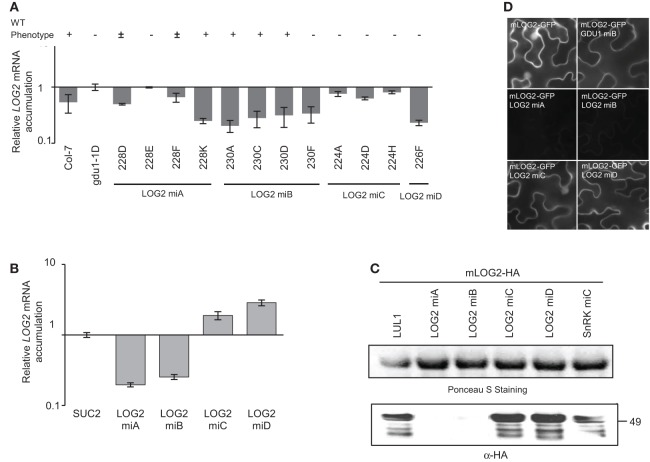Figure 1.
Effects of artificial miRNAs targeting LOG2 in stably transformed Arabidopsis and in transiently transformed N. benthamiana. (A) amiRNAs targeting LOG2 (LOG2 miA, miB, miC and miD) were stably introduced into the gdu1-1D Arabidopsis mutant. The phenotype of about 20 progenies of each transformant line was recorded (“+,” wild type; “±,” intermediate between Gdu1D and WT; “−,” Gdu1D). mRNA level of LOG2 in each line was measured by qRT-PCR, normalized with ACT2 and expressed relative to the level in gdu1-1D. (B) Relative LOG2 mRNA levels in transiently transformed N. benthamiana. mLOG2 (ubiquitination inactive LOG2) was co-expressed with SUC2 or amiRNALOG2 (see main text). LOG2 mRNA levels were measured by qRT-PCR and expressed relative to levels in leaves transformed with mLOG2 and SUC2. Co-expression of SUC2 was used as co-expression control. (C) Western blot detection of the accumulation of the mLOG2 protein (ubiquitination inactive LOG2), when co-expressed transiently with four amiRNALOG2 in N. benthamiana. amiRNASnRK1.1-C (SnRK miC) was used as non-targeting amiRNA negative control. Numbers on the right indicate molecular weight in kDa. Co-expression of LUL1 (see main text) was used as co-expression control. (D) Analysis of amiRNAs effect on mLOG2-GFP fluorescence in transiently transformed N. benthamiana epidermis cells. Fluorescence microscope pictures were all taken with the same settings. Error bars represent standard error of at least three biological replicates.

